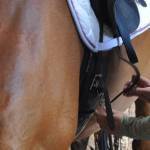Girth Aversion in Horses: Gastric Ulcers Pinpointed

Saddle enough horses and you will run into one that detests girthing. A horse that is sensitive to cinch-fitting, sometimes called a “girthy horse,” usually displays signs of protest, including tossing the head, pinning ears, wringing the tail, stomping a foreleg, kicking out with a hind leg, and worse. Is girthiness an expression of resistance, a sign of shaky work ethic, or could there be an underlying cause?
Veterinary researchers set out to determine the causes of girthiness in a retrospective study of 37 horses admitted to the University of California, Davis. Although identifying the exact cause for girth aversion remains a challenge, 12 of the horses studied were diagnosed with gastric ulceration. In addition to gastric ulcers, the horses were found to have sundry orthopedic issues (10 horses), ill-fitting saddles (3), reproductive tract neoplasia (1), and various diseases (10), including liver abscessation, vena cava aneurism, sternum pain, and urinary tract infection.
“Even though saddle fit seems a logical leaping-off point when assessing girthiness, veterinarians and nutritionists have long believed that there could be a possible gastrointestinal component to this problem,” explained Catherine Whitehouse, M.S., a nutrition advisor with Kentucky Equine Research. “An unhappy gastrointestinal tract leads to problems, as all horse owners know. Unlike colic, however, low-level, protracted discomfort can lead to behavioral problems. In this way, girthiness may be similar to hindgut acidosis.”
Gastroscopy is the gold standard in assessing stomach health, especially in confirming the presence of ulcers. If found, gastric ulcers can be healed through a complete course of omeprazole as prescribed by a veterinarian. As omeprazole therapy winds down, a research-proven preventive should be added to the diet. In addition to a high-quality digestive supplement, management strategies to reduce ulcer formation include:
- Offering good-quality forage at all times. “If that’s not feasible,” said Whitehouse, “never allow more than a couple hours without suitable forage.”
- Reducing grain meals to meet, not exceed, energy requirements above forage. “Not only will this help with ulcer prevention, this will keep horses in moderate body weight, delaying onset of metabolic disease in susceptible horses and reducing the load on joints.”
- Supplying alfalfa hay, if appropriate, as it features natural buffering properties that keep ulcers from forming.
Girthiness can also occur in driving horses, which display the same adverse behavior as riding horses when the girth, also called a bellyband or belly-girth, is fastened.
Millares-Ramirez, E.M., and S.S. LeJeune. 2019. Girthiness: Study of 37 horses (2004-2016). Journal of Equine Veterinary Science 79:100-104.








